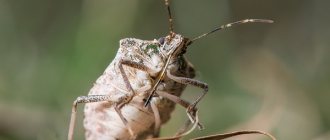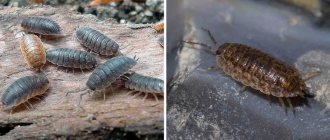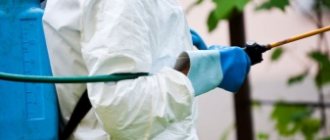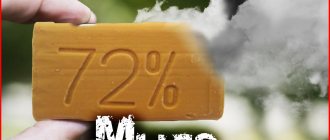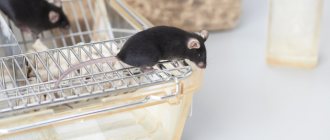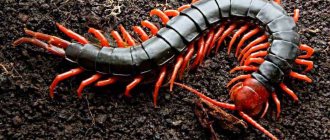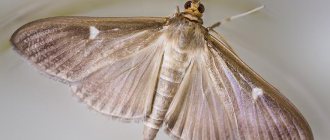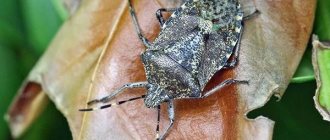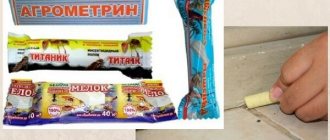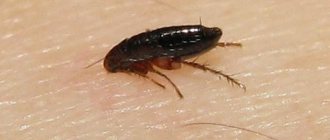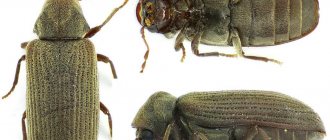General information:
Medyanitsa is an aggressive pest of fruit crops. It is often found in steppe and forest-steppe zones, as well as in garden areas where apple and pear trees grow. Despite its small size, the parasite is dangerous. People often call the copperhead “leaf”.
All parasites of this species are sucking pests that emerge in the spring from overwintered larvae. As soon as spring comes, honey beetles are absorbed into the leaves and young ovaries, feeding on the valuable juices of the plant. The leaves themselves are covered with sticky secretions of the honeydew, honeydew. Because of this dew, flower stalks and leaves stick together, turn black and die. When the larva turns into an adult insect, the attack on the plant does not stop, but actively continues.
As a rule, in our territories, copperheads develop only in one generation. Although, in warmer southern regions they can develop in 3-4 generations.
The pest initially appears on the plant in the form of small larvae, which rarely reach a length of more than a millimeter. The larvae of the copperhead are characterized by a sedentary lifestyle. The body is flat in shape and light yellow in color. Five instars must pass before the larva fully matures.
The period of maturation of the copperhead lasts from two weeks to a month, it all depends on the ambient temperature. The minimum heat threshold that is suitable for the development of the parasite: +10 degrees.
When the copperhead grows up, it reaches a length of three millimeters. As a rule, the body is already quite brightly colored, has a green or bluish tint (although much will depend on the species). A rear pair of jumping legs develops (like those of fleas), and thin and long whiskers can be noted on the head. There are also wings: large and transparent.
Egg laying occurs sometime in early June. The female lays up to two dozen eggs in one clutch, and the average lifespan of a female is only a month. Although, on the other hand, in such a short period she manages to lay more than a thousand eggs!
The main signs of the appearance of copperhead on trees
Psyllids may not be immediately visible on fruit trees, since their size is too small. However, the amount of damage caused by these pests can be significant when the insect colony grows large. Therefore, you should know the main symptoms of the appearance of copperhead on fruit trees in order to begin fighting them as early as possible.
The larvae of this pest usually settle in unopened buds - this is where you should look for them in early spring
. And on pear trees, it is the buds that are attacked by adult psyllids.
The main symptoms of the appearance of psyllids on apple and pear trees are:
- since the copperhead sucks the cell sap from the foliage and flowers, when the foliage and buds suddenly turn yellow and fall off in the spring, you can understand what kind of pest has settled on the fruit tree;
- foliage affected by copperhead slows down development and becomes deformed;
- if the copperhead fed on buds, flowers or ovaries, then they begin to dry out;
- deformed fruits form from the surviving ovaries, and their flesh becomes tasteless and tougher than usual;
- Another symptom of the appearance of psyllids on trees is the appearance of a sticky, sweetish liquid on the leaf blades - a waste product of the “harmful” bug. It covers the foliage completely, or accumulates next to the copperhead in the form of small balls. The main danger of this liquid is that it can stick the buds together, preventing the development of leaves and ovaries;
- Apple and pear trees become weaker after an attack by this pest, so they can be affected by pathogenic microorganisms.
Honeydew that appears on leaf blades can become an excellent environment for the development of various pathogens, in particular sooty fungus.
It gradually covers the entire leaf, interfering with the process of photosynthesis.
If sooty fungus moves onto apples and pears, their appearance and taste deteriorate sharply.
How dangerous is honeydew for plants?
The copperhead is a sucking insect. As soon as she leaves the egg, she moves to the most delicious part of the plant and, having pierced the top layer with her proboscis, begins to drink the juices. He loves to eat young leaves that have not yet blossomed from the buds. When the leaves appear, cuttings and stalks are a special delicacy for the copperhead.
Affected trees are easy to recognize: the foliage turns yellow ahead of time, the ovary falls off. The leaves look underdeveloped and their overall density decreases. Plus, you can notice sweet secretions from fleas on the branches, and colonies of fungi can form.
What harm do they cause?
Psyllids suck sap from the green parts of plants. This leads to the fact that the leaves begin to take on an ugly shape and become smaller. The buds and flowers of fruit trees dry out, and the harvest is characterized by clumsiness.
Another aspect of the damage is the psyllid excrement, called honeydew. You can also come across the term “honeydew”. This substance contains a lot of sugar, which attracts ants. A coating of honeydew prevents leaves, peduncles and buds from developing properly, gluing them together from the inside. Honeydew is a fertile environment for the proliferation of various types of harmful fungi, such as sooty fungus. A sign of its activity is a black coating on the plant.
External signs of damage
The copperhead received its nickname “leaf flea” because of the small larvae that deal the first blow to the plant and begin to feed on it even in the phase when the leaves are in bud state. The larvae are very voracious, and they leave behind a sweet, honey-like rose, which will be the first sign of external damage to the plant.
At the site of heavy dew contamination, soon the leaves and flowers turn black, dry out and fall off. If the damage is severe, then the dormant buds may not begin to grow. Adult copperheads also eat the plant, but no longer excrete dew behind them.
In early spring, it is recommended to inspect the trees and pay attention to buds that did not bloom on time. These are the favorite habitats of copperhead larvae.
What external signs of damage should you pay special attention to:
- young leaves, buds and ovaries die due to the fact that the pest actively sucks out the juices;
- the leaves become deformed, the buds grow poorly, and the flowers simply dry out. The fruits will have irregular shape and tasteless pulp;
- the trees themselves are weakened and severely damaged by pathogenic microorganisms;
- the appearance of sticky sweet liquid on the buds, shoots and leaves. The mucus can completely cover the leaves, and the accumulation of larvae looks like a transparent ball;
- fruits are covered with plaque, look unappetizing and have an unpleasant taste.
Lifestyle and harmfulness
The apple honeydew is a monophage. It only damages the apple tree.
Damage to the apple tree is caused by nymphs, which attach themselves to young leaves and flowers even before the buds open. Damaged buds dry out and fall off, and the leaves develop much more slowly and can be 8...10 times smaller than healthy ones (there is, however, evidence that the area decreases by 15...52% - see the lectures of the State Agrarian University, edited by Slepchenko). If the leaves are severely damaged, the tree does not have enough nutrients to form a normal harvest: it discards a significant part of the ovary and forms fewer fruit buds the next year. According to some reports, the vital activity of the apple honeydew can lead to the loss of 15% of flowers and leaf rosettes.
Insects not only suck out the juice, but also excrete large amounts of sticky, sugary excrement. The latter have the appearance of whitish balls covered with a thin shell of a wax-like substance. Wax is secreted by special perianal glands. These balls blur and form a sticky mass that glues the leaves and parts of the bud inside the buds, floods the stomata and impairs aspiration and respiration. In addition, apple psyllid excrement serves as a substrate for the development of sooty fungi, which also impair the functioning of the leaf.
Preventive actions
To reduce the number of parasites of any kind on your plants, it is important to carry out autumn tillage on time. Fertilizing with mineral fertilizers enhances the natural protective functions of the plant. Mineral fertilizers can also be included in prevention, because this will increase the osmotic pressure of cell sap, and sucking insects, including the copperhead, do not like this.
In the fall, as a preventive measure against the appearance of parasites next year, it is imperative to clear the trees of old bark, trunks, and skeletal branches. It is also recommended to remove fallen leaves and rotten fruits that are in the ground from the site. It is also recommended to prune the crown.
hawthorn
Hawthorn
Damages the buds, buds, flowers and leaves of pome and stone fruit crops, bird cherry and hawthorn. As a result, individual branches, and sometimes entire trees, are exposed. Young caterpillars overwinter in winter nests made of leaves entwined with cobwebs hanging on trees. Each nest can contain up to 100 caterpillars, grayish-brown in color with three black and two brown-orange stripes on the back. The caterpillar's body is covered with hairs and its head is black.
In the spring (when the buds swell), the caterpillars emerge from their wintering grounds and begin to feed, eating away the buds. Later they damage leaves, buds and flowers. At the end of May - beginning of June, the caterpillars complete their development and pupate on the trunks and branches of trees, attaching themselves to them with silky hairs. The pupa is yellowish or grayish-white with black dots.
The butterfly emerges 10-12 days after pupation. The butterfly is large, with white wings and black spots on them. She lays yellow eggs in clusters on the leaves of fruit trees. After 10-15 days, caterpillars hatch from the eggs. For some time they feed on leaves, skeletonizing them, then weave nests from the leaves, in which they overwinter. Each caterpillar inside the nest is in a separate white cocoon.
Control measures
- Removing and burning winter nests in winter or early spring.
- In the spring (after buds break), spray with 0.2% chlorophos against caterpillars emerging from cocoons.
- After flowering, as well as at the end of summer during the hatching of young caterpillars, spray with chlorophos.
How to deal with Medyanitsa?
The fight against the copperhead is a multi-stage and quite complex process. But, if you find out where the larvae overwinter, how they then feed and reproduce, then all the necessary measures can be carried out correctly and on time. The best time to destroy larval colonies is during bud break and before flowering. You can use an infusion of tobacco smoke to spray the plant. In more severe cases of infection, measures to combat the pear worm or other type of parasite include spraying with chemicals.
When using strong chemical or biological preparations, you can spray the plant only until the buds open. It is important to take all precautions.
Pear gall mite
The tick is cylindrical, very small. Damages apple, pear, and quince trees. Adult ticks overwinter under the bud scales. In spring, females begin to feed and lay eggs early, even before the buds open. The larvae penetrate the tissue of young leaves and suck out the juice from them. In the feeding areas of the mites, mainly along the central vein of the leaf, small swellings form - at first reddish, then they become black. Leaves damaged by mites dry out. In autumn, mites migrate from the galls to the buds. Over the summer, the tick develops in 2-3 generations.
Measures to combat brown, red apple, yellow plum and pear gall mites. Spraying apple and pear trees in the period from the beginning of bud break to the pinking of the buds with karbofos, Apollo or colloidal sulfur in the presence of an average of 10 eggs per fruit branch 10 cm long or 3-4 mites per rosette of buds.
During the summer, spraying with the same preparations or neoron is recommended. The threshold of harmfulness is 3 mites per leaf.
Methods of dealing with the copperhead
Medicines for Medyanitsa
If the larvae can be seen openly on the pedicels, then the best way to combat the copperhead is to use the drug. For spraying, you can use such popular and widespread products as “Karbofos”, “Phosfamide”, “Metaphos” or an excellent drug for the honey worm “Tiofos”.
Spraying a plant with these drugs negatively affects not only the life of parasites, but also beneficial insects. For example, bees. In order not to harm the bees, spraying the tree should be carried out 1-2 weeks before flowering.
Treatment with these preparations can also be considered a preventive measure for the destruction of such common pests as aphids, caterpillars, spider mites, copperheads, and other types of parasitic butterflies.
Folk methods of struggle
To protect plants from honeymoon in early spring, you can make homemade decoctions that are used for spraying. In such a situation, spraying must be carried out only until the buds open.
What infusions to use:
- yarrow;
- tobacco;
- soap solution;
- ash solution.
If spraying during the period of bud formation did not work, and the copperhead continues to attack, then treatment measures can be carried out during the blooming period. For example, you can use tobacco smoke, which negatively affects already adult individuals.
To carry out the procedure of baiting a copperhead with tobacco smoke, you need to collect piles of dry grass on the site, and pour 2 kg of tobacco waste on top. For three hours, or even more, smoke your garden. Most insects will weaken after this procedure and fall off the trees. To prevent them from rising again, you need to quickly dig up the soil.
To prevent honeymoon bugs from settling on the site, it is necessary to isolate the crops of trees and various vegetable crops from coniferous trees (this is especially true for the activities of the carrot honeymoon).
The copperhead is a dangerous enemy of the harvest in the garden or vegetable garden. To get rid of it in the initial stages, you can use traditional methods. If they do not show effectiveness, you will have to switch to strong chemicals.
Reproduction
Adult carrot psyllids rarely overwinter in vegetable gardens. They prefer forest edges and coniferous trees. They wake up when it gets warm. In our area, the psyllid season begins in late April or early May. However, this depends on the stability of the weather.
Mating of insects begins immediately after waking up and occurs most often on carrot tops. The females lay their eggs there.
The carrot psyllid is very prolific. At one time, it is capable of laying more than 40 eggs, and over its entire short life - up to 800. After two weeks, larvae form from the eggs, which cause the main damage to carrots. They suck out the juice by biting through the shell of the leaves.
After a month of active feeding, the larvae turn into butterflies and immediately begin to continue their kind. The appearance of the second generation of carrot psyllid usually occurs in mid-summer, and in the northern regions - at the end of summer. That is why it is difficult to fight it, and gardeners are only interested in effective methods of control.
This insect goes to wintering in advance, without waiting for cold weather.
Types of copperhead:
Apple sucker
This is a small parasitic insect that belongs to the jumping and sucking species. It can be green or yellow, less often brown. Adults have well-developed wings. From the name of the species it is clear that such a honey worm poses the greatest danger to apple trees. Characterized by bisexual reproduction. As a result of its vital activity, the apple honeydew envelops the vegetative organs with a sweet, waxy substance. Overwinters successfully in the egg phase.
Description
You can recognize the psyllid from the photo below. This is a small, very mobile insect: it is not easy to photograph. Therefore, the efforts of the photo authors are respected.
Adults
- Body length up to 2.5 mm.
- The head and chest are yellowish-green.
- The abdomen is green.
- The antennae and legs are yellow.
- The wings are much longer than the body, transparent, with yellowish veins.
- In autumn, some insects turn a dark red color. In males, two longitudinal orange stripes appear on the back.
Eggs
- The eggs are oblong-oval, with a hollow stalk at the base.
- The color of the eggs is orange.
Nymphs
- The body shape is flattened.
- Body color ranges from yellow to green.
- Wing cases appear in third instar nymphs.
How to recognize psyllid among other garden pests
If you see curled leaves in the garden, you can be sure that a psyllid has come to you. It looks like a microscopic dragonfly - a pale green insect with transparent wings. Adults are sometimes called nymphs. Its dimensions do not exceed 1.7 mm, but the scope of the disaster that it brings with it far exceeds the span of its wings:
- females produce up to 5 offspring per season, each clutch containing at least 500-700 eggs;
- the larvae start eating very quickly, therefore, if measures are not taken in time, the garden will turn black, because “sooty” mushrooms also settle on the sweet syrup that they leave behind, which literally turns the tree black;
- When the population of these insects is high, not only the leaves, but also the fruits of the plants suffer. They become smaller, lose their taste and presentation.
